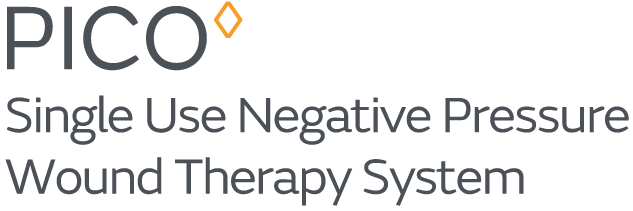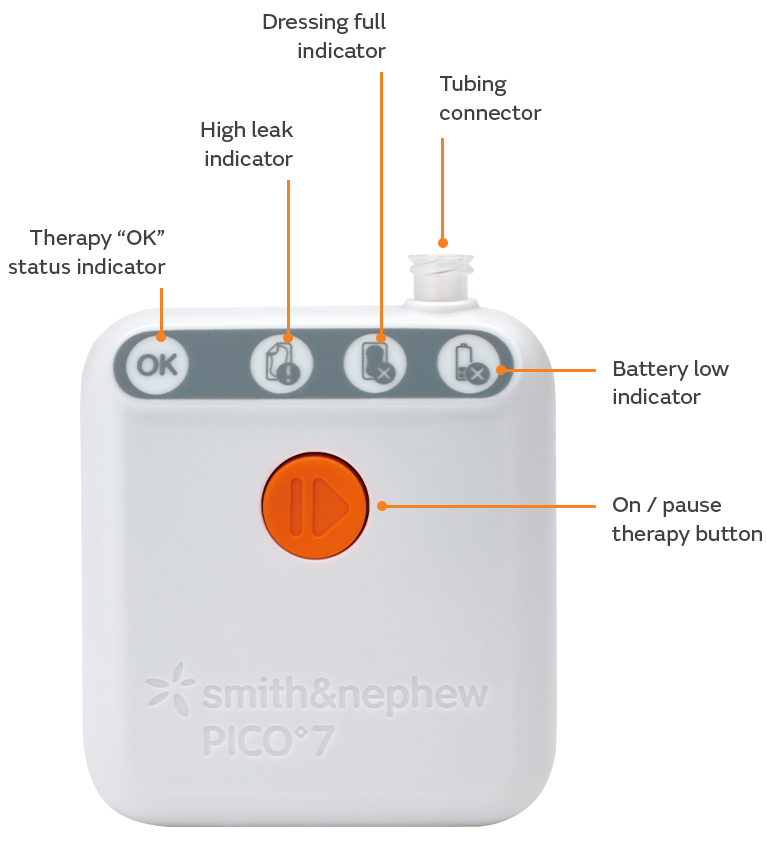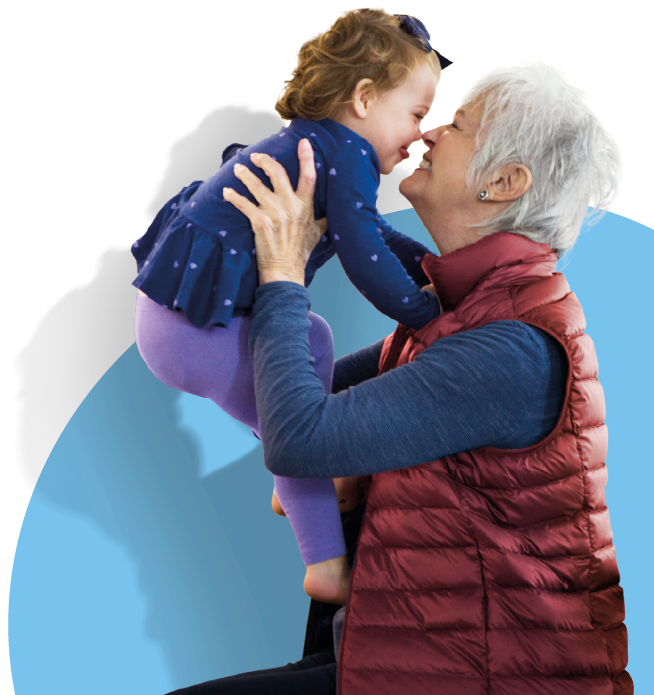What is PICO 7 sNPWT?
The PICO 7 sNPWT is a wound care system, which provides suction known as Negative Pressure Wound Therapy (NPWT). This draws out excess fluid from a wound and provides a compressive force1,2 protecting the injured area from getting dirty3 to ultimately help promote healing. The PICO sNPWT 7 system consists of an NPWT pump connected to an absorbent gentle adhesive dressing.1-6
The front of the pump had a single push button and four LEDs, to provide you with visual indications on the status of your system. Please refer to the How PICO sNPWT 7 works section for descriptions on the specific visual indicators.
Daily activities with PICO sNPWT
How does the PICO 7 sNPWT system work?
Battery
On the front of the pump, the green OK indicator and orange battery low indicator will flash together when the batteries need changing.

On the reverse of the pump, the battery cover can be slid on and off, with visual arrow indicators to simplify the insertion and removal of batteries.7

Press the orange button to pause the therapy. Slide the battery cover off from the top of the pump and replace with two new alkaline AA batteries. Put the cover back on and press the orange button to restart your therapy.
Air leaks
If a high air leak has been detected, an orange leak indicator will flash. You will hear the pump make a buzzing sound as it tries to get to the right vacuum.

Smooth down around the outside of your dressing including the strips with your hands to remove any creases. Ensure that the tube connectors have been twisted together securely.
Press the orange button to restart your therapy. If the air leak remains, the orange leak indicator will flash again after approximately 60 seconds.
Please contact your healthcare professional if you have continuous issues with the flashing orange air leak light.
Dressing
The dressings have a wear time of up to 7 days depending on the amount of fluid from the wound.1,7 This will depend on the size, type, drainage amount and position of your wound. Your healthcare professional will determine how often your dressings should be changed.

If the dressing is saturated or the filter is blocked, the orange dressing full indicator will flash. Please contact your healthcare professional to replace the dressing with a new one.
Frequently asked questions
Are there audible alerts?
PICO 7 sNPWT does not contain audible alerts. Please carry PICO 7 sNPWT so it is accessible and can be checked routinely.
How do I change my dressing?
PICO 7 sNPWT dressings should only be applied, changed and removed by a healthcare professional.
How do I know my system is working normally?
While the PICO 7 sNPWT pump is working correctly, the green OK indicator will flash continuously. The pump may be heard running occasionally as it maintains the negative pressure. This is normal.
The dressing should have a slightly wrinkled appearance and feel firm to the touch.
The pump life ends and it automatically stops functioning at 7 days (all the indicators will turn off at this point).
How do I disconnect my pump in preparation for washing or showering?
The pump should remain connected the dressing at all time unless there is a requirement to disconnect the pump – such as the need to wash or shower.
Firstly press the orange button to pause the therapy. Unscrew the two parts of the connector. Place the pump somewhere safe. Ensure the end of the tubing attached to the dressing is facing down so that water does not enter the tube while the pump is disconnected.
Once you are ready to reconnect the pump, join the pump and dressing tubes by twisting together the connectors. Press the orange button to start application of negative pressure wound therapy. The green OK indicator and orange air leak indicator will start to flash together (indicates pump working to establish negative pressure wound therapy).
Depending on the size of the wound, the pump should take up to 65 seconds to establish NPWT.
Magnet safety
The PICO pumps contain a MAGNET. Keep the PICO pumps at least 4 inches (10 cm) away from other medical devices at all times. As with all electrical medical equipment, failure to maintain appropriate distance may disrupt the operation of nearby medical devices. For full product and safety information, please see the Instructions for Use. These include but are not limited to:
- Implantable cardioverter-defibrillator (ICD)
- Pacemakers
- Insulin pumps
- Shunt valves
- Neurostimulators
- Cochlear implants
THIS WARNING APPLIES AT ALL TIMES TO ALL USERS.
This applies to both patients and caregivers. You must keep the PICO 7 sNPWT pump at least 4 inches (10cm) away from other systems:
- If you have an electronic system and are helping take care of somebody else using the PICO 7 sNPWT system.
- If you are wearing the PICO 7 sNPWT pump in a public area where you may come in close contact with someone else who has an electronic medical system.
What happens if my system becomes wet?
Do not let the pump get wet. Protect it from the sources of fluid e.g. from incontinence or spillages. Do not use PICO 7 sNPWT if it is wet or has previously been wet. In addition, your dressing should not be exposed to a direct spray or submerged in water.
Please contact your healthcare professional if you note or suspect your system has become wet.
What should I do if I notice a big change in the color or amount of the fluid in the dressing?
Please contact your healthcare professional immediately if you notice any of the following changes:
- If it changes from clear to cloudy or bright red
- You see the dressing fill rapidly with blood
- Your wound looks more red than usual or has a foul smell
- The skin around your wound looks reddened or irritated
- The dressing feels or appears loose
- You experience pain
- The visual indicator(s) do not turn off
Will it be painful?
The first time the PICO 7 sNPWT pump is turned on, you may feel a slight pulling or drawing sensation. If you experience any pain, please speak to your healthcare professional for advice. They may prescribe pain-relief medication.
Use of PICO sNPWT in the treatment of Diabetic Foot Ulcers (DFUs)
A patient perspective-Kevin’s story
- Smith & Nephew January 2018. Summary Wound Model Report for Opal, PICO 7. Internal Report. DS.18.015.R.
- Smith & Nephew 2015.A Prospective, Open, Non-Comparative, Multi-Centre Study to Evaluate the Functionality and Dressing Performance of a New Negative Pressure Enhanced Dressing (NPED) in Acute Wounds. Internal Report. CT09/02 ST865.
- Hudson, D.A., Adams, K.G., Van Huyssteen, A., Martin, R., Huddleston, E.M.Simplified negative pressure wound therapy: clinical evaluation of an ultraportable, no-canister system. Int Wound J. 2015;12(2):195-201.
- Payne, C., And Edwards, D., .Application of the Single Use Negative Pressure Wound Therapy Device (PICO) on a Heterogeneous Group of Surgical and Traumatic Wounds. ePlasty. 2014;14:152-166.
- Sharp, E.Single-use NPWT for the treatment of complex orthopaedic surgical and trauma wounds. Journal of Wound Care. 2013;22(10):S5-S9.
- Stryja, J., Staffa, R., Říha, D., Stryjová, K., Nicielniková, K.[Cost-effectiveness of negative pressure wound therapy in outpatient setting]. Rozhledy v chirurgii : mesicnik Ceskoslovenske chirurgicke spolecnosti. 2015;94(8):322-328.
- WMP/11446.UEF/R3. Project Fairbanks US Human Factors Summary Report Issue 6. G Walker. December 2017.





